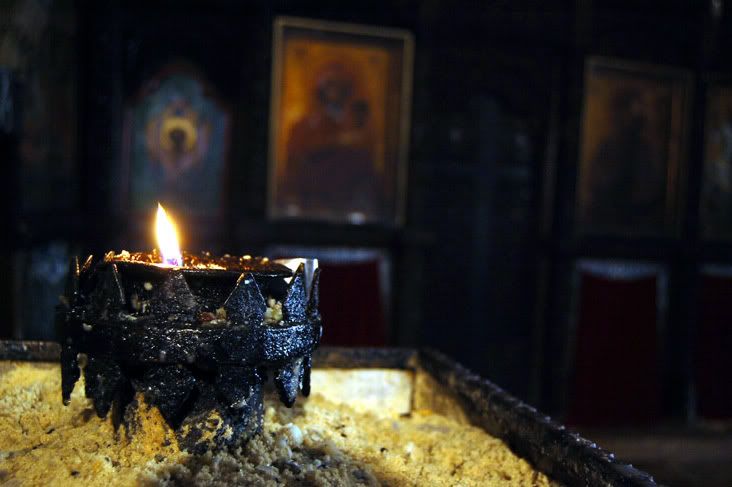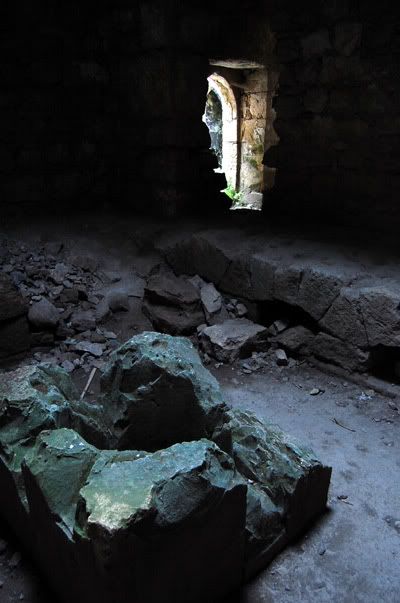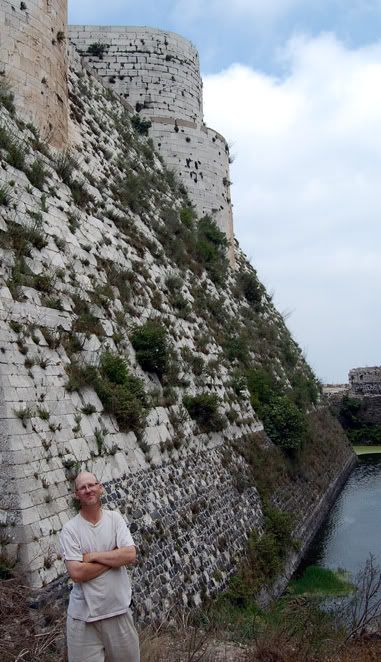Round the World 2010 Leg 2.9
Through the gap.
We made the journey into the Homs gap, but took many winding mountain roads at first instead of taking the main highway. We did this in order to visit sites along the way. We first went to a castle at Misyaf. I don’t remember the exact history of it, but I think it was an anti-crusader fort. Such forts paralleled each other and many castles changed hands after succumbing to sieges, only to change hands again at a later date. The fortress is impressive, but I’ve heard that the Crac is so stunning that I’m glad we saw the smaller one first, otherwise it would have been anticlimactic.
Next we were to stop at the monastery of St. George. We continued through the mountains and caught views of the Crac des Chevaliers itself standing tall on the next mountain over, surveying the wide plain below. We stopped by the side of the road to get pictures and I noticed that on the mountain above us was a gigantic statue and next to it a building with a gigantic cross. Was this what I thought it was? I asked. Yes, this was a giant Jesus and that was a very big church. This region along the coast is heavily Christian, the Maronite sect being most common, left over in a way from the crusader battles so long ago (though the Christian community in the area goes back some 1500 years. The modern Christians here are staunchly Syrian, though, proud of their country and having no trouble with the Arabs. It is interesting, however, that Homs and Hama are bastions of conservative Islam, seemingly watching their neighboring Christian region just as the anti-crusader forts once watched the crusader castles across the gap.

The monastery is interesting. It has been here a long time, but much of the current construction is relatively new. Even the part labeled as ‘the old church’ is only about 200 years old and ‘the new church’ was built in 1897. Both contain artifacts from a much earlier period. And all over are icons of St. George, images of him defeating his dragon. A fitting place for this, the patron saint of England, in a land that so many English crusaders fought.
[I show a picture of a lamp burning in the old church with icons in the background. I'm experimenting with photography and I think I'm getting better.]
Have fun storming the castle!
I’ve heard of the crack of dawn before, but the Crac of Knights? Crac (or krak) is castle and the Chevaliers in this case are those knights that most people think of when they have cause to conjure images of such armored men--the Knights Templar and the Knights Hospitaler. In fact, Crac des Chevaliers is one of the most famous sites in Syria and well deserved of that position.
It’s such an imposing structure that it’s really difficult to do it justice. You need an aerial shot even to get a sense of its enormity. There are many available online (link to UNESCO page about the site) but I found I just couldn’t get a shot that showed the castle that could possibly give the impression of what I’m seeing. I got a lot of pictures inside, but again, they don’t conjure the feel of the place as a whole. Here’s a shot inside one of the rooms showing some broken and collapsed stone, as well as a basin of sorts.


[Here I am at the base of part of the fortification and onthe other side, a picture from inside one of the rooms I explored below, this one not too far down yet]
Some people feel that the lack of furnishings or displays in the rooms detracts from the impact. I think it adds to it. Hard to explain exactly why. I understand that with displays I might learn a bit more about the history, come to understand the point of the rooms, their location and use, but for me that’s only part of it. I suppose I like to use my imagination, think out why this room was important or what might have happened herein. Sure, I might well be wrong, but it’s the archaeologist in me as well as the creative side. I like using my imagination and in this case it doesn’t matter much if I’m wrong, I’m still thinking about what might have happened and even sometimes setting stories in my head right here in the room I’m exploring.
Furthermore, the more you have displays and artifacts and signs in rooms, the more you have to have guards and set paths and rules. I like to be able to explore a big castle like this, not worrying too much about pathways or following guide signage or guides themselves. Much of what a guide tells you fades from your memory anyway, but the things you imagine and really feel, those stay with you. True history? Well, what is that anyway? I do pay attention to ‘reality’ but I also like to live the imaginary from time to time and places like this allow me to do that. I remember doing similarly in a castle in Scotland called Craigmillar. I was there some 20 years ago and was the only visitor apart from the herd of cattle outside it. I called it the Castle McMoo after that clan of cattle and created my own world inside while I visited. Call me crazy, but it was fun.
The most fun I had at the Crac was descending a flight of stairs that started in a kind of courtyard. I had no idea where I was going and it quickly got very dark. Then another set went further down, even darker. My companions didn’t follow, but I ventured in, feeling my way down. I used my camera to get a little light, its autofocus light would cast just enough illumination. I turned a corner and descended more. Then caught sight of a bit of light and new I was coming to something. A room opened up with a hole going up to the surface, a breathing hole I suppose. It was a very interesting, dark and dank room. And I was surprised to find yet another set of stairs going down. I didn’t have time to go there, though I sorely wanted to. Instead, I took the stairs back up after a quick imaginative look round the deep dungeon I was now in.
We wandered all over the castle, but much of my creative mind remained in that deep, dark hallway.